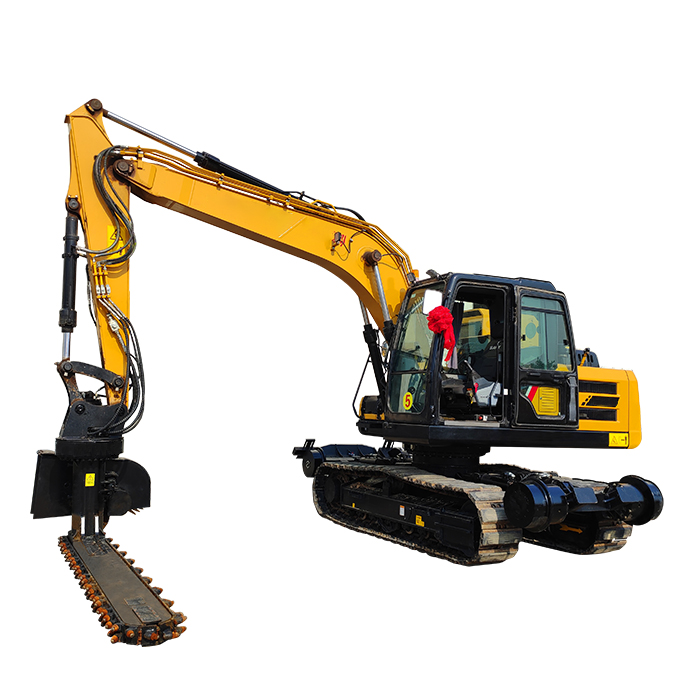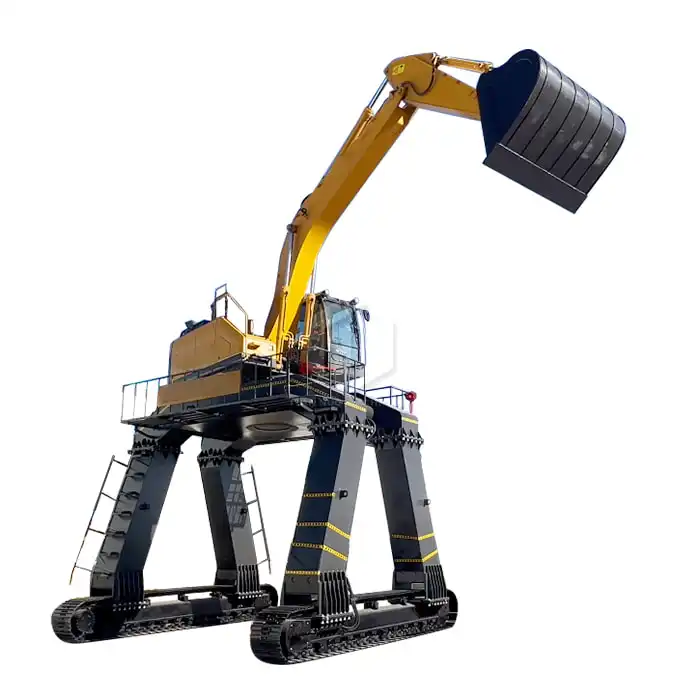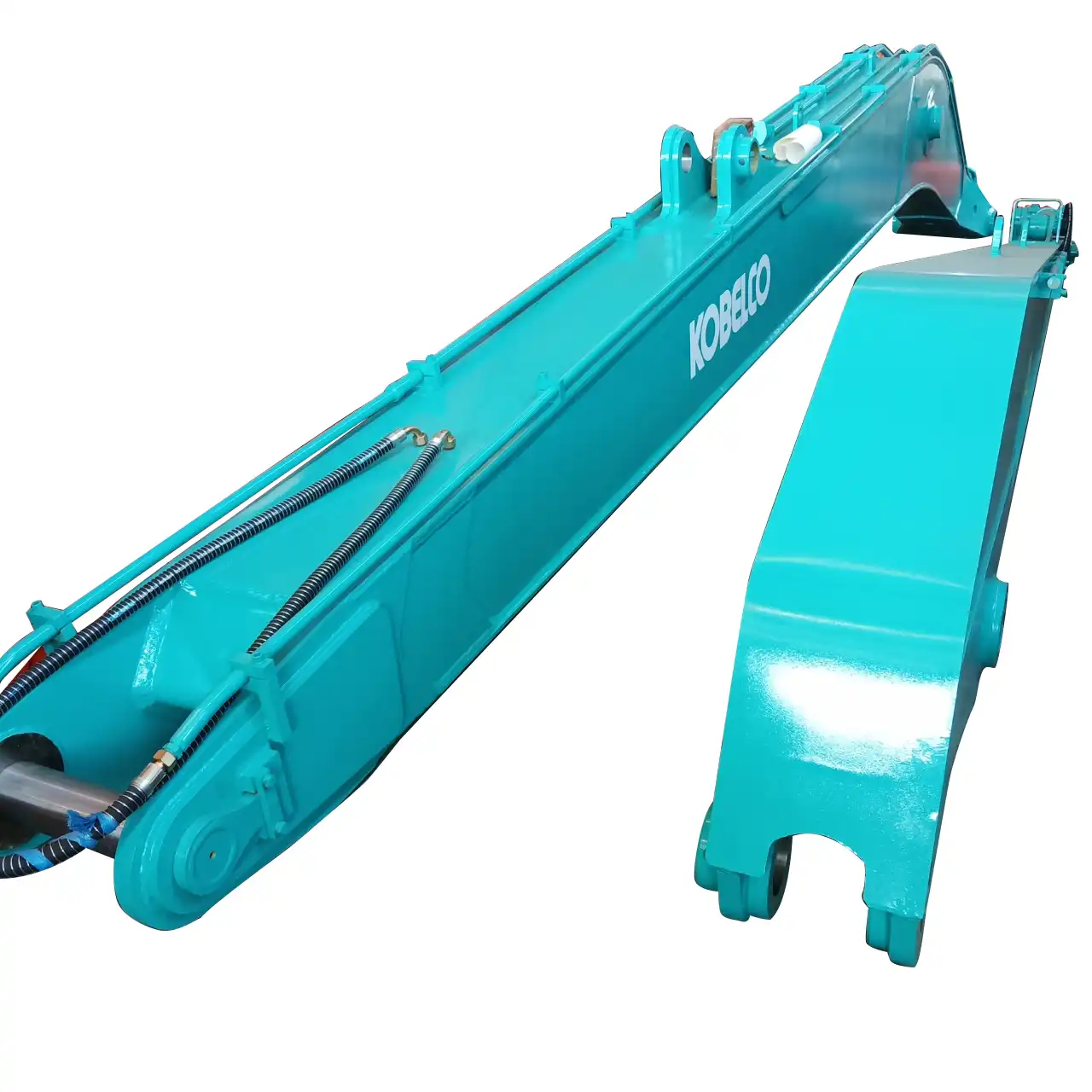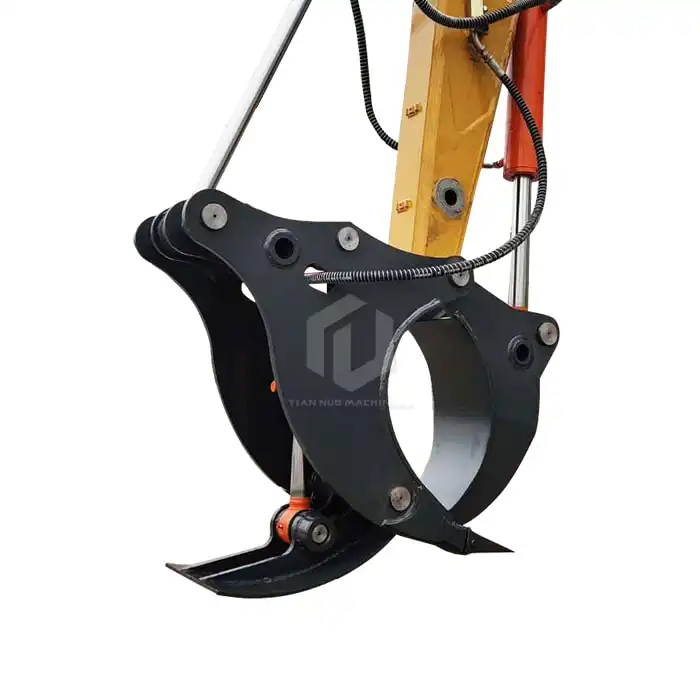What are the maintenance requirements for a railway cleaning bucket?
Railway excavator cleaning buckets are essential tools for maintaining track cleanliness and safety. These specialized attachments require regular maintenance to ensure optimal performance and longevity. Key maintenance requirements include structural integrity checks, hydraulic system evaluations, and wear component assessments. Regular cleaning, lubrication, and inspection of bucket teeth, adapters, and wear plates are crucial. Additionally, addressing common wear issues such as lip deterioration and hydraulic leaks is vital for maintaining the bucket's effectiveness in railway maintenance operations.

Essential Cleaning Bucket Inspection Checklist
Structural integrity assessment of bucket components
Maintaining the structural integrity of a railway excavator cleaning bucket is paramount for ensuring safe and efficient track maintenance operations. Begin by conducting a thorough visual inspection of all welded joints, paying close attention to areas prone to stress, such as the bucket's corners and connection points. Look for signs of cracking, deformation, or corrosion that could compromise the bucket's strength.
Next, examine the bucket's shell for any dents, punctures, or thinning of the material. These issues can arise from repeated impacts with ballast or other debris during cleaning operations. Use a thickness gauge to measure the shell's thickness at various points, comparing the results to the manufacturer's specifications.
Don't forget to inspect the bucket's mounting brackets and pivot points. These areas experience significant stress during operation and are critical for the bucket's stability and performance. Check for any loose bolts, worn bushings, or excessive play in the connections. Replace any damaged or worn components immediately to prevent further deterioration and potential equipment failure.
Hydraulic system and connection point evaluation
The hydraulic system is the lifeblood of a railway excavator cleaning bucket, powering its movements and functions. Start your evaluation by checking all hydraulic hoses for signs of wear, abrasion, or leaks. Pay special attention to areas where hoses may rub against each other or the bucket structure during operation.
Inspect hydraulic cylinders for smooth operation and any signs of oil leakage around seals or rod wipers. Extend and retract the cylinders fully, listening for unusual noises or observing any jerky movements that could indicate internal damage or contamination.
Examine all hydraulic fittings and connection points for tightness and proper sealing. Look for any signs of seepage or accumulated dirt around connections, which could indicate a developing leak. Clean these areas thoroughly and re-tighten as necessary, being careful not to over-tighten and damage the threads or seals.
Wear plate and cutting edge condition analysis
Wear plates and cutting edges are crucial components that directly impact the cleaning bucket's performance and longevity. Begin by measuring the thickness of the wear plates at multiple points, comparing them to the manufacturer's wear limits. Uneven wear patterns can indicate alignment issues or improper use of the bucket.
Inspect the cutting edge for signs of excessive wear, chipping, or deformation. A sharp, properly maintained cutting edge is essential for efficient penetration of compacted ballast and debris. If the cutting edge has worn beyond the manufacturer's recommended limits, plan for its replacement to maintain optimal cleaning efficiency.
Don't overlook the condition of the bucket's side cutters and corner protectors. These components play a crucial role in protecting the bucket's structure and maintaining its shape. Replace them if they show significant wear or damage to prevent accelerated wear on the main bucket structure.
Preventive Maintenance Schedule For Optimal Performance
Daily cleaning and lubrication procedures
Implementing a daily maintenance routine is crucial for keeping your railway excavator cleaning bucket in top condition. Start each day by thoroughly cleaning the bucket to remove any accumulated dirt, debris, or ballast. Use a pressure washer to clean hard-to-reach areas, paying special attention to pivot points and hydraulic connections.
After cleaning, inspect the bucket for any visible damage or wear that may have occurred during the previous day's operations. This quick visual check can help identify potential issues before they escalate into more serious problems.
Lubrication is key to preventing premature wear and ensuring smooth operation. Apply grease to all lubrication points as specified in the manufacturer's manual. Pay particular attention to pivot pins, bushings, and any moving parts. Use a high-quality, water-resistant grease suitable for heavy-duty applications to ensure proper protection even in harsh railway environments.
Weekly bucket teeth and adapter inspection
Bucket teeth and adapters are critical components that directly impact the cleaning efficiency of your railway excavator bucket. Set aside time each week to thoroughly inspect these parts for wear and damage.
Check each tooth for signs of excessive wear, chipping, or breakage. Measure the length of the teeth and compare them to the manufacturer's wear limits. Rotate or replace teeth as needed to maintain an even wear pattern and optimal cleaning performance.
Examine the adapters that hold the teeth in place. Look for any cracks, deformation, or looseness in the adapter-to-bucket connection. Ensure that all locking mechanisms are functioning correctly and that the teeth are securely fastened to the adapters.
Monthly hydraulic hose and seal replacement check
Hydraulic system integrity is vital for the safe and efficient operation of your railway excavator cleaning bucket. Dedicate time each month to a comprehensive inspection of all hydraulic components.
Carefully examine all hydraulic hoses for signs of wear, cracking, or abrasion. Pay special attention to areas where hoses may rub against each other or the bucket structure. Replace any hoses that show signs of deterioration, even if they haven't yet failed, to prevent unexpected downtime.
Inspect hydraulic seals and O-rings for signs of leakage or degradation. Look for any oil residue or discoloration around cylinder rods, valve bodies, and pump housings. Replace seals proactively if you notice any signs of wear or leakage to maintain system efficiency and prevent contamination.

Common Wear Issues And Solutions
Addressing bucket lip and side cutter deterioration
The bucket lip and side cutters are among the most vulnerable components of a railway excavator cleaning bucket, constantly subjected to abrasive wear during operation. To address deterioration in these areas, start by assessing the extent of wear. Use a straight edge to check for any unevenness or deformation along the bucket lip.
For minor wear, consider hardfacing the affected areas. This process involves applying a wear-resistant weld material to the worn surfaces, effectively rebuilding and reinforcing them. Be sure to use appropriate hardfacing techniques and materials suitable for the bucket's base metal and operating conditions.
In cases of severe wear or when the lip thickness has been reduced beyond acceptable limits, replacement may be necessary. Consider upgrading to higher-grade materials or specialized wear-resistant alloys for the replacement parts to extend their service life in demanding railway cleaning applications.
Repairing or replacing damaged wear plates
Wear plates play a crucial role in protecting the bucket's structural integrity. When damage is detected, prompt action is essential. For minor damage or uneven wear, grinding and re-welding can often restore the wear plate's protective function. Ensure that the repair work is carried out by qualified personnel using appropriate welding procedures to maintain the plate's integrity.
If wear plates have thinned significantly or show extensive damage, replacement is the best course of action. When replacing wear plates, consider upgrading to materials with higher abrasion resistance, such as chromium carbide overlay plates, which can offer extended service life in harsh railway environments.
Pay attention to the installation process when replacing wear plates. Proper fitment and welding techniques are crucial to ensure the new plates provide optimal protection and don't create weak points or stress concentrations in the bucket structure.
Resolving hydraulic leaks and pressure loss problems
Hydraulic leaks and pressure loss can significantly impact the performance and efficiency of your railway excavator cleaning bucket. To resolve these issues, start by conducting a thorough inspection of the entire hydraulic system. Use hydraulic test gauges to check system pressure at various points and compare the readings to the manufacturer's specifications.
For external leaks, tightening fittings or replacing damaged seals and O-rings often solves the problem. However, be cautious not to over-tighten fittings, as this can cause damage and create new leak points. Use appropriate thread sealants when reassembling hydraulic connections to ensure a leak-free seal.
Internal leaks, often characterized by slow operation or a lack of power, may require more extensive repairs. This could involve rebuilding or replacing hydraulic cylinders, valves, or pumps. Always use OEM or equivalent quality parts to ensure compatibility and maintain system integrity.
Proper maintenance of railway excavator cleaning buckets is crucial for ensuring efficient and safe track maintenance operations. By adhering to a rigorous inspection checklist, following a preventive maintenance schedule, and addressing common wear issues promptly, you can significantly extend the lifespan of your equipment and optimize its performance. Remember that regular cleaning, lubrication, and timely repairs are key to avoiding costly downtime and maintaining the integrity of your railway infrastructure. Investing in quality maintenance practices not only enhances the reliability of your cleaning buckets but also contributes to the overall safety and efficiency of your railway operations.

FAQ
①How often should I inspect my railway excavator cleaning bucket?
Perform daily visual inspections, weekly detailed checks of bucket teeth and adapters, and monthly comprehensive evaluations of the hydraulic system and structural components.
②What are the signs that my bucket's wear plates need replacement?
Look for significant thinning, deep gouges, cracks, or areas where the base metal is exposed. If wear plate thickness is reduced by more than 50% of its original thickness, replacement is typically necessary.
③Can I use regular grease for lubricating my railway cleaning bucket?
It's best to use a high-quality, water-resistant grease specifically designed for heavy-duty applications. This ensures proper protection in the harsh railway environment.
④How do I know if my bucket's hydraulic system is losing pressure?
Signs include slow or weak operation, unusual noises during operation, and visible oil leaks. Use hydraulic pressure gauges to check system pressure against manufacturer specifications.
⑤Is it necessary to replace all bucket teeth at once?
While it's not always necessary to replace all teeth simultaneously, doing so ensures even wear and optimal performance. At minimum, replace teeth in matching pairs or sets to maintain balance.
China Railway Excavator Cleaning Bucket Manufacturer
When looking to purchase excavator cleaning buckets, it's essential to consider manufacturers with a proven track record in the industry. TianNuo Machinery, a reputable Chinese manufacturer, offers high-quality cleaning buckets designed for optimal performance and durability. Their products are known for their efficiency and reliability in railway maintenance operations.
TianNuo Machinery stands as a leading manufacturer of railway excavator cleaning buckets in China. With a comprehensive range of railway maintenance equipment, including sleeper changing machines, screening machines, and tamping machines, TianNuo Machinery offers solutions tailored to the diverse needs of the railway industry. Their excavator cleaning buckets boast cutting-edge features such as side cutting capabilities, high excavation efficiency exceeding 30 m³/h, and customizable excavation lengths. For those seeking reliable and efficient railway maintenance equipment, you can contact us at rich@stnd-machinery.com. TianNuo Machinery's expertise extends beyond railway equipment to include excavator modifications, engineering arms, and a wide array of excavator accessories, making them a one-stop solution for various construction and maintenance needs.
When selecting a cleaning bucket, consider factors such as the specific requirements of your railway maintenance projects, the compatibility with your existing equipment, and the after-sales support offered by the manufacturer. TianNuo Machinery's commitment to quality and customer satisfaction makes them a reliable choice for railway maintenance professionals seeking efficient and durable cleaning bucket solutions.
References
- TianNuo Machinery Official Website
- Railway Track Maintenance Best Practices Guide
- Excavator Bucket Maintenance Manual
- Journal of Railway Engineering and Management
- Construction Equipment Maintenance Handbook
- Railway Ballast Cleaning and Management Techniques
About Author: Arm
Arm is a leading expert in the field of specialized construction and railway maintenance equipment, working at Tiannuo Company.
YOU MAY LIKE
 VIEW MOREBallast Blaster Undercutter
VIEW MOREBallast Blaster Undercutter_1756791633631.webp) VIEW MOREExcavator Three Section Demolition Boom
VIEW MOREExcavator Three Section Demolition Boom VIEW MOREUnloading Train Excavator Long Legs
VIEW MOREUnloading Train Excavator Long Legs VIEW MOREBallast plough
VIEW MOREBallast plough VIEW MORELong Reach Boom for Kobelco Excavator
VIEW MORELong Reach Boom for Kobelco Excavator VIEW MOREHydraulic Ballast Tamper
VIEW MOREHydraulic Ballast Tamper_1758183275256.webp) VIEW MORELong Reach Boom for Hitachi Excavator
VIEW MORELong Reach Boom for Hitachi Excavator VIEW MOREExcavator Tree Stumper
VIEW MOREExcavator Tree Stumper

